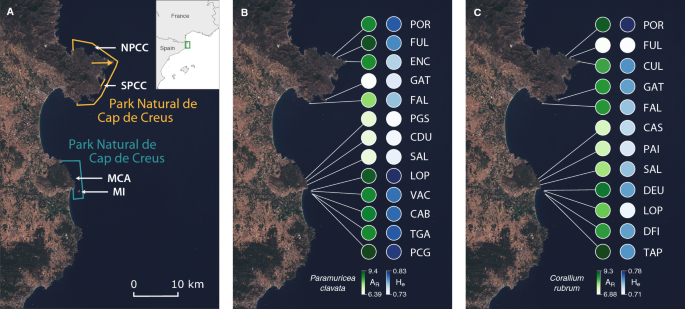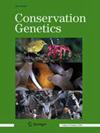两个海洋保护区形成栖息地的八爪珊瑚的比较种群遗传学:生态进化和管理意义
IF 1.7
3区 环境科学与生态学
Q2 BIODIVERSITY CONSERVATION
引用次数: 0
摘要
当前阻止生物多样性下降的努力主要基于保护物种丰富度。这种狭隘的关注忽视了生物多样性的关键组成部分,特别是物种间的遗传多样性,这对于考虑在不断变化的环境中进行遗传适应至关重要。虽然比较群体遗传学被认为是改善生物多样性管理的一种相关方法,但在实践中却很少被考虑。本文对两种主要生境形成物种红珊瑚(Corallium rubrum)和clavata Paramuricea进行了种群遗传学比较研究,以期为地中海西北部两个海洋保护区的管理提供参考。尽管它们有许多共同的生物学特征,生活在相似的栖息地,但在两个物种中观察到遗传多样性和结构的对比模式。由物种特异性生殖策略和人口统计历史引起的差异遗传漂变效应最有可能解释这些差异。将我们的结果转化为管理策略支持了四个管理单元的定义。我们确定了遗传多样性的冷点和遗传多样性的热点,遗传多样性在系统的连通性中起着核心作用。有趣的是,它们分别对应于最新和最古老的保护区。这个案例研究表明,从“物种模式”的角度转向“生态进化过程”的角度可以帮助评估和促进生物多样性管理计划的有效性。本文章由计算机程序翻译,如有差异,请以英文原文为准。

Comparative population genetics of habitat-forming octocorals in two marine protected areas: eco-evolutionary and management implications
Abstract Current efforts to halt the decline of biodiversity are based primarily on protecting species richness. This narrow focus overlooks key components of biological diversity, particularly the infra-species genetic diversity, which is critical to consider with respect to genetic adaptation in changing environments. While comparative population genetics is recognized as a relevant approach to improve biodiversity management, it is still barely considered in practice. Here, a comparative population genetics study was conducted on two key habitat-forming octocoral species, Corallium rubrum and Paramuricea clavata , to contribute to management of two Marine Protected Areas (MPAs) in the northwestern Mediterranean. Contrasting patterns of genetic diversity and structure were observed in the two species, although they share many common biological features and live in similar habitats. Differential genetic drift effects induced by species-specific reproductive strategies and demographic histories most likely explain these differences. The translation of our results into management strategies supports the definition of four management units. We identified a coldspot of genetic diversity, with genetically isolated populations, and a hotspot of genetic diversity that has a central role in the system’s connectivity. Interestingly, they corresponded to the most recent and the oldest protected areas, respectively. This case study shows how moving from a “species pattern” perspective to an “eco-evolutionary processes” perspective can help assess and contribute to the effectiveness of biodiversity management plans.
求助全文
通过发布文献求助,成功后即可免费获取论文全文。
去求助
来源期刊

Conservation Genetics
环境科学-生物多样性保护
CiteScore
3.80
自引率
4.50%
发文量
58
审稿时长
1 months
期刊介绍:
Conservation Genetics promotes the conservation of biodiversity by providing a forum for data and ideas, aiding the further development of this area of study. Contributions include work from the disciplines of population genetics, molecular ecology, molecular biology, evolutionary biology, systematics, forensics, and others. The focus is on genetic and evolutionary applications to problems of conservation, reflecting the diversity of concerns relevant to conservation biology. Studies are based on up-to-date technologies, including genomic methodologies. The journal publishes original research papers, short communications, review papers and perspectives.
 求助内容:
求助内容: 应助结果提醒方式:
应助结果提醒方式:


